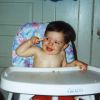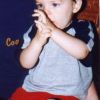This blog contains some basic information about teaching baby sign language much of it drawn from the site Signing Baby.com. For more detailed information, pictures of babies signing, and helpful hints I suggest visiting their website.
Most parents start with need based signs such as: milk, more, drink, hungry, all done, sleep, diaper, etc. These signs allow your child to tell you when they need something. Once your baby has mastered the need-based signs then you can add other signs that your baby finds motivating. Think about what your child enjoys, if your child loves books or to play with balls teach him the sign for book or ball. You might also teach your baby a sign for mommy, daddy, or their siblings’ names.
 |
 |
 |
 |
 |
| apple | daddy | more | help | monkey |
By six months of age most babies have enough hand coordination that they can start using baby sign language. Begin my choosing a few basic signs, usually about 3, that you want to teach your child. Then show your child that sign during the activity. You will also want to say the word. Every time you feed him use the eat sign and say, “eat.” At about one year I taught my daughter to tell me if she was all done eating by patting her tray at the end of the meal, saying “all done,” then getting her down. It wasn’t long before I would ask “All done?” and she would pat her tray if she was and would not if she wanted more food.
The important thing is that you do the sign every time. So your baby begins to relate the sign with the event. Saying what the sign is important as well. It helps your child develop their speech as well as their baby sign language skills.
Days before your child makes the sign they will understand what the sign means and will respond accordingly. Once your child begins signing the sign to you then it’s time to introduce some new signs. Don’t stop using the old signs just add new ones.
It doesn’t take long for babies to realize that they can get their needs met by using signs. Thus they will learn new signs quicker and use old signs more often. They will often want to know the signs for objects so that they can talk about or express their desire for the object.
Oftentimes a child will use the same sign for more than one object, especially if the signs are similar. Monica Beyer of Signing Baby.com explains, ” Signs that have a similar hand shape will often start out the same … that is, your baby may be making the same sign for several words. One that I noticed was “ball” … “more” … “hurt” … they all are two-handed signs where the hands are brought together. This can be compared to a child saying “ba” for several words, such as “ball” … “bird” … “balloon.” This is all perfectly normal and all to be expected. Your challenge will be to figure out what your baby is trying to tell you … just use context. If you’re feeding your child, he might want more, but if he’s playing, he might want his ball.”
Baby sign language can be rewarding. I have previously written about the benefits of baby sign language. And no it does not decrease your child’s speech and language acquisition in fact recent studies show that baby sign language actually helps.

